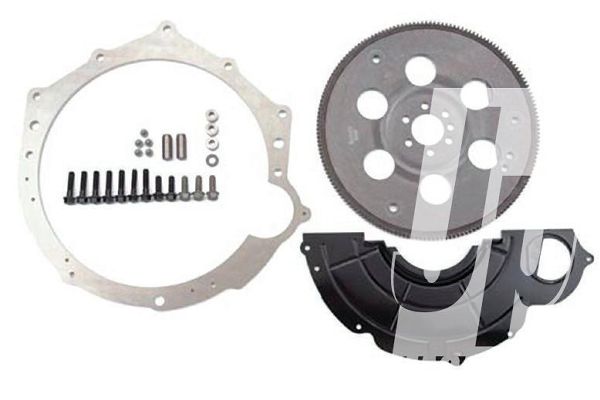
 Pete Trasborg
Brand Manager, Jp
Pete Trasborg
Brand Manager, Jp
Using our normal bull-in-a-china-shop approach, we were able to get the wrong transmission behind an engine that it wasn’t designed for. Of course, we didn’t know that at the time, and built the transmission mount, mounted the T-case, and hooked up the shifter cables. But that wasn’t all. We also had custom driveshafts built and had them half installed when we realized we hadn’t bolted the torque converter to the flexplate. So we stopped in the middle of the front driveshaft install to discover that the bolt holes in the torque converter didn’t line up with the flexplate.
But wait, this transmission was behind this engine before. It was an LT-1 and a 4L60E. Those should go together like frat guys and beer kegs, right? As it turns out it is a little more complicated than that, and over the course of a couple of months with Dave Dibs at Orange County Transmissions, we learned way more about the 4L60E transmission than we ever wanted to.
Once we learned that there were four distinct versions of the transmission found behind V-8s, we decided it would be a great story if we could tell you what year/make/model GM vehicle you needed to rob a transmission from in order to bolt it up to your swapped-in small-block GM V-8 in your Jeep. Unfortunately, GM phased the early version out, even as it was phasing the later version in. And if that wasn’t enough, there were also the same platforms from the same years that used different versions of this transmission -- and these may or may not work with the engine you have. Regardless of not having a straight year/make/model cheat sheet, this is a good transmission with a low first gear, useable overall length, and good strength and durability. So, who’s on first? Let us try to make it way clearer than mud.
PhotosView SlideshowIdentification and the Differences
There are four main differences to the 4L60E that started in some ’92 GM vehicles (Corvettes) and ran for the next couple of decades. It looks very much like the 700R4 that it replaced, but don’t be fooled. They are so close that the 700R4 was also known as a 4L60 after just a few minor changes. The 4L60E has no kickdown or TV cable, and all of that work is done through solenoids that are run thanks to a VSS at the back of the transmission.
Nomenclature
4L60E
4: Four forward speeds
L: Longitudinally mounted (there is also a “T” version (Transverse mounting, such as in a Corsica or Ciera))
60: Rated for a 6,000-pound Gross Vehicle Weight (although GM did put it in some larger trucks up to and over 8,000 pounds)
E: Electronically shifted
 It is possible to go from an earlier engine to a late trans- mission or vice-versa by swapping bellhousings, input shafts, pumps, and torque converters, but that will run you $700-$1,000. Fortunately, Pace Performance stocked this GMP adapter kit (PN 19154766) for $206.95 that allows us to use our later LSx 4L60E with our ’94 LT-1. There is also a kit that allows use of the earlier 4L60E with an LS engine (PN 12563532) that comes in under $100 even after adding bolts. So unless you have to have your transmission completely rebuilt anyway, it is probably going to be less expensive to use one of the two adapter kits if you do grab the wrong transmission.
It is possible to go from an earlier engine to a late trans- mission or vice-versa by swapping bellhousings, input shafts, pumps, and torque converters, but that will run you $700-$1,000. Fortunately, Pace Performance stocked this GMP adapter kit (PN 19154766) for $206.95 that allows us to use our later LSx 4L60E with our ’94 LT-1. There is also a kit that allows use of the earlier 4L60E with an LS engine (PN 12563532) that comes in under $100 even after adding bolts. So unless you have to have your transmission completely rebuilt anyway, it is probably going to be less expensive to use one of the two adapter kits if you do grab the wrong transmission.
When 60 Is More Than 80
A lot of Jeep guys want to go right to the 4L80E for their porky or big-tired Jeep, but the fact is there are even four-door JKs running 4L60Es with no problems. The 4L60E is lighter, shorter, and has a better First gear ratio than the 4L80E does. While the 4L80E has less slip between Third and Fourth gears, it is hard to beat the First gear in the 4L60E for a rig that sees even occasional crawling. While there are other transmissions with huge followings and parts availability, more and more people are looking for that low First gear and Overdrive. The 4L60E is pretty much the Chevy small-block of the automatic transmission world with more aftermarket support and parts availability than any other auto today.
When 60 Is More Than 80
Model
4L60E
4L80E
Length (in)
21.9
26.25
Weight (lbs)
163.2
254
Gear Ratios
First
3.06:1
2.48:1
Second
1.63:1
1.48:1
Third
1.00:1
1.00:1
Fourth
0.70:1
0.75:1
Reverse
2.29:1
2.07:1
Maximum Torque (ft-lb)
360
440
Removable Bellhousing?
Yes
No







